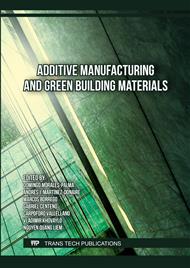[1]
S. Ford and M. Despeisse, "Additive manufacturing and sustainability: an exploratory study of the advantages and challenges," J. Clean. Prod., vol. 137, p.1573–1587, 2016
DOI: 10.1016/j.jclepro.2016.04.150
Google Scholar
[2]
M. Attaran, "The rise of 3-D printing: The advantages of additive manufacturing over traditional manufacturing," Bus. Horiz., vol. 60, no. 5, p.677–688, 2017
DOI: 10.1016/j.bushor.2017.05.011
Google Scholar
[3]
S. Garzon-Hernandez, A. Arias, and D. Garcia-Gonzalez, "A continuum constitutive model for FDM 3D printed thermoplastics," Compos. Part B Eng., vol. 201, p.108373, 2020
DOI: 10.1016/j.compositesb.2020.108373
Google Scholar
[4]
S. Wickramasinghe, T. Do, and P. Tran, "FDM-Based 3D printing of polymer and associated composite: A review on mechanical properties, defects and treatments," Polymers (Basel)., vol. 12, no. 7, p.1–42, 2020
DOI: 10.3390/polym12071529
Google Scholar
[5]
K. M. Lee, H. Park, J. Kim, and D. M. Chun, "Fabrication of a superhydrophobic surface using a fused deposition modeling (FDM) 3D printer with poly lactic acid (PLA) filament and dip coating with silica nanoparticles," Appl. Surf. Sci., vol. 467–468, no. September 2018, p.979–991, 2019.
DOI: 10.1016/j.apsusc.2018.10.205
Google Scholar
[6]
K. Midtdal and B. P. Jelle, "Self-cleaning glazing products: A state-of-the-art review and future research pathways," Sol. Energy Mater. Sol. Cells, vol. 109, no. 7465, p.126–141, 2013
DOI: 10.1016/j.solmat.2012.09.034
Google Scholar
[7]
X. Chen, L. Hu, and Y. Du, "Anti-icing and anti-frost properties of structured superhydrophobic coatings based on aluminum honeycombs," Mater. Chem. Phys., vol. 291, no. April, p.126683, 2022
DOI: 10.1016/j.matchemphys.2022.126683
Google Scholar
[8]
Y. Tan et al., "Improving Anti-Humidity Property of a SnO2-Based Chemiresistive Hydrogen Sensor by a Breathable and Hydrophobic Fluoropolymer Coating," Langmuir, vol. 38, no. 45, p.13833–13840, 2022
DOI: 10.1021/acs.langmuir.2c01982
Google Scholar
[9]
W. Li, H. Yang, S. Xue, T. Shi, Q. Wang, and H. Peng, "A simple strategy towards construction of fluorine-free superhydrophobic aluminum alloy surfaces: self-cleaning, anti-corrosion and anti-frost," Appl. Phys. A Mater. Sci. Process., vol. 128, no. 7, p.1–13, 2022
DOI: 10.1007/s00339-022-05758-9
Google Scholar
[10]
A. Le Duigou, A. Barbé, E. Guillou, and M. Castro, "3D printing of continuous flax fibre reinforced biocomposites for structural applications," Mater. Des., vol. 180, p.107884, 2019
DOI: 10.1016/j.matdes.2019.107884
Google Scholar
[11]
M. Kariz, M. Sernek, M. Obućina, and M. K. Kuzman, "Effect of wood content in FDM filament on properties of 3D printed parts," Mater. Today Commun., vol. 14, no. November 2017, p.135–140, 2018
DOI: 10.1016/j.mtcomm.2017.12.016
Google Scholar
[12]
J. V. Ecker, A. Haider, I. Burzic, A. Huber, G. Eder, and S. Hild, "Mechanical properties and water absorption behaviour of PLA and PLA/wood composites prepared by 3D printing and injection moulding," Rapid Prototyp. J., vol. 25, no. 4, p.672–678, 2019
DOI: 10.1108/rpj-06-2018-0149
Google Scholar
[13]
M. A. Osman and M. R. A. Atia, "Investigation of ABS-rice straw composite feedstock filament for FDM," Rapid Prototyp. J., vol. 24, no. 6, p.1067–1075, 2018
DOI: 10.1108/rpj-11-2017-0242
Google Scholar
[14]
L. Ma, J. Wang, Z. Zhang, Y. Kang, M. Sun, and L. Ma, "Preparation of a superhydrophobic TiN/PTFE composite film toward self-cleaning and corrosion protection applications," J. Mater. Sci., vol. 56, no. 2, p.1413–1425, 2021
DOI: 10.1007/s10853-020-05364-1
Google Scholar
[15]
J. M. Barrios and P. E. Romero, "Improvement of Surface Roughness and Hydrophobicity in PETG Parts Manufactured via Fused Deposition Modeling (FDM): An Application in 3D Printed Self–Cleaning Parts," Materials (Basel)., vol. 12, no. 15, p.2499, Aug. 2019
DOI: 10.3390/ma12152499
Google Scholar
[16]
H. Yang, F. Ji, Z. Li, and S. Tao, "Preparation of hydrophobic surface on PLA and ABS by fused deposition modeling," Polymers (Basel)., vol. 12, no. 7, 2020. https:/doi.org/
DOI: 10.3390/polym12071539
Google Scholar
[17]
K.-M. Lee, H. Park, J. Kim, and D.-M. Chun, "Fabrication of a superhydrophobic surface using a fused deposition modeling (FDM) 3D printer with poly lactic acid (PLA) filament and dip coating with silica nanoparticles," Appl. Surf. Sci., vol. 467–468, no. October 2018, p.979–991, Feb. 2019
DOI: 10.1016/j.apsusc.2018.10.205
Google Scholar
[18]
M. Barahman and A. M. Lyons, "Ratchetlike Slip Angle Anisotropy on Printed Superhydrophobic Surfaces," Langmuir, vol. 27, no. 16, p.9902–9909, Aug. 2011. https:/doi.org/10.1021/la201222a |
DOI: 10.1021/la201222a
Google Scholar
[19]
Z. He et al., "Fabrication of Polydimethylsiloxane films with special surface wettability by 3D printing," Compos. Part B Eng., vol. 129, p.58–65, 2017
DOI: 10.1016/j.compositesb.2017.07.025
Google Scholar
[20]
R. Jafari, C. Cloutier, A. Allahdini, and G. Momen, "Recent progress and challenges with 3D printing of patterned hydrophobic and superhydrophobic surfaces," Int. J. Adv. Manuf. Technol., vol.103, no.1-4, p.12251238, 2019
DOI: 10.1007/s00170-019-03630-4
Google Scholar
[21]
AENOR, "UNE-EN ISO 25178-1:2016. "Geometric product specification (GPS) Surface quality: Areas Part 1: Indication of surface texture" p.1–3, (2016)
Google Scholar
[22]
N. Astm and N. Iso, "Designation : D 570 - 98 Standard test method for the water absorption of plastics"
Google Scholar



